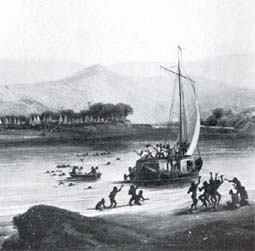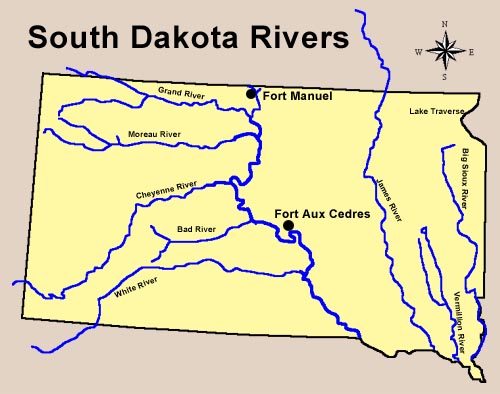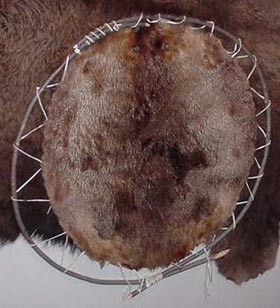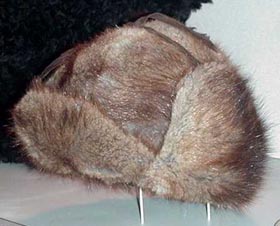|
Lesson 1
"Old Misery" and the Fur Trade
|
| |
|
The Missouri River was like an interstate highway. There was a lot
of traffic. The Arikaras and Mandans used bullboats to
cross from side to side. Lewis and Clark went up and down. On
their way down, they met fur traders hurrying upriver as fast as
their keelboats could carry them. Today we would not think
this was very fast. The Missouri River had earned the nickname
"Old Misery." Strong currents and mud made upriver
travel hard work. Snags from dead trees could slow travel to a
mile or so a day. Still, it was the quickest and easiest way to
get from one point to another. It was also a pipeline of supplies.
Trading goods came up the river, and animal pelts went down the
river.
|

Keelboat
|
|
|
|
There were a few fur traders in South Dakota before Lewis and
Clark came. Pierre Dorion was one. Registre Loisel was another.
Loisel built a trading post on an island. He called it Fort Aux
Cedres. It was near what is now Pierre. Then Lewis and Clark
made their reports. They told about the peoples and animals they
had found. It was 1806. Many more fur traders headed up the river.
|
|

South Dakota Rivers Map
|
Manuel
Lisa was a businessman. He
was one of the first to build a company in the area. He left Saint
Louis with twenty-five men. They went up the Missouri River to
trade. This was the start of the Missouri Fur Company. Lisa built
trading posts all along the Missouri River. Other fur traders
built posts on the
tributaries
of the Missouri River. Soon there were also posts along the James
River and the Big Sioux River. |
| |
|
|
Fur traders had to work closely with American Indians. The tribes
were master traders. They traded beaver, muskrat, mink, deer, and
buffalo hides. The fur traders gave them guns, gunpowder, and
tobacco. They also traded flour, sugar, coffee, blankets, kettles,
cloth, and beads. Trade was built on
relationships. Fur traders and Indian
nations had to be partners. But sometimes they all fought with
each other.
|

Photo courtesy of South Dakota State
Historical Society
|
|
|
|
|

Photo courtesy of South Dakota State
Historical Society
|
Countries
also fought about the fur trade. Both Great Britain and the United
States wanted to control the fur trade. British
agents built posts in what is now North
Dakota. They began to build their own relationships with Indian
nations. Robert Dickson was a British agent. He started a post in
eastern South Dakota. It was near Lake Traverse. He married a
Nakota woman. She was the daughter of a Yanktonnais chief.
|
|
|
The
trading posts were often called forts, but they were not
military bases. A trading post was
usually a bunch of cabins huddled along the banks of a river.
Still, the United States and Great Britain wanted more trading
posts. The fur business was a good one. It made high
profits. The posts also set up
relationships with Indian nations. Soon the United States and
Great Britain were at war. It was called the War of 1812. Both
countries wanted to control the fur trade.
No battles
took place in South Dakota, but people in South Dakota took part
in the war. Manuel Lisa became an agent for the United States. He
was the official voice of the American government. He asked the
Dakotas and Lakotas to stand by his country. British agents worked
with the Nakotas. Some of the Yanktonnais tribe fought with the
British army. The war ended in 1815. The United States won. It now
had control of the fur trade along the Missouri River.
|
| Vocabulary |
|
| agents (n.), people who speak for a company or
country
military (adj.), relating to war or the armed forces of
a country
profits (n.), gains; money or goods left after costs
are met
|
relationships (n.), connections between people
tributaries (n.), rivers that flow into a larger river
|
|
|